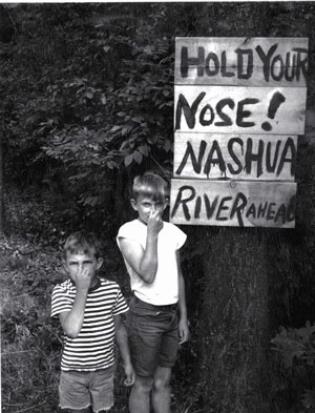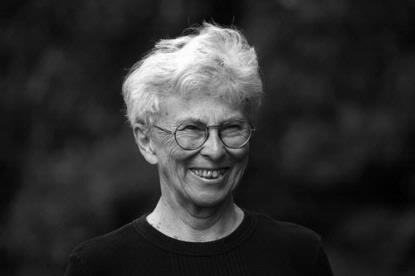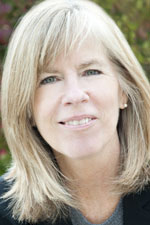
True stories of hope, grit, empowerment, and positive change are rarely spotlighted in today’s celebrity-obsessed culture and character-bashing media. Why do we reward questionable behavior with our attention? Would we not nurture a more civil society if we focused on the inspiring stories that influence us to live lives of character, passion, learning, and service for the common good?
One person whose story inspires me is citizen leader, Marion Stoddart, who spearheaded one of the most vital environmental success stories in American history, right here in Massachusetts.
Marion’s citizen activism united people from different disciplines around a common cause to make a real and lasting difference in the well-being of our communities.
Marion made a difference–and so can each of us.
How it all started
For the Nashua River, 1960 was not a good year. The river was decidedly unriver-like in color, taking on  thehue of what color paper the local mills were processing that day. And the stench, oh, yes, that was quite memorable too. Years of industrial waste, local dumping and neglect had led to a dying river.
thehue of what color paper the local mills were processing that day. And the stench, oh, yes, that was quite memorable too. Years of industrial waste, local dumping and neglect had led to a dying river.
Enter a woman–the focused and committed Marion Stoddart, who led our communities in their fight to put the MA Clean Water Act into place. The clean up of the river and its banks improved quality of life in the 31 watershed communities in north central Massachusetts and southern New Hampshire. Today, the river draws swimmers, kayakers, and fishermen—not to mention economic development that brings vitality and tax dollars to the region.
One person—she roused policy makers, business leaders, politicians, and a skeptical public to advocate for cleaning up what seemed a hopeless toxic sludge pit, the Nashua River. Her story shows how it is possible for ordinary people like the members of our own communities to join together to make a difference.
Getting her story out
The Mass Humanities supported Work of 1000 film shares the story of this citizen leader. Her approach is an eye-opening inspiration to those who see crucial social challenges (like global warming) but don’t think they can do anything about them. The film follows Marion and the people she motivated to join her as they pushed through the river clean up agenda.
As Marion suggests, “You must be optimistic and positive thinking. Never associate with negative thinking people. You cannot change their minds. Surround yourself with positive thinking people. It is exciting, synergistic, powerful, and fun.”
And many people agree with my assertion that we need more stories of hope and inspiration. We’ve had great success with the film and over the last 14 months, we’ve shown it to thousands of students, community members, scientists, and environmental leaders.
Technology as an Agent of Change
The technical aspects of keeping waterways clean are fascinating to young and old students of science and engineering. Understanding how the science works can be important to becoming a credible advocate.
Marion spent years educating herself and getting to know the people who understood how the system works so that when she spoke, it was with the authority that comes from understanding.
Ask yourself, what do you need to learn in order to be a better advocate?
Expanding the Impact
Our program has evolved since we produced the film as we received audience requests for Marion to speak following a film showing. Seeing the film created an open-minded moment: People were moved and energized. They wanted to know more about Marion’s approach to activism and how they could get involved.
The film truly has the power to motivate others to participate in crucial social issues. Pairing it with a discussion led by Marion herself –a real and accessible model (a regular person like you and me, not a superhero), who leads change is an even more powerful experience for those who participate.
Shannon Saywell, a high school senior from Groton, MA said, “So many adults have told me that ‘you’ can make a difference, but I never believed them. But hearing Marion’s story and meeting her changed all that, and helped me believe that even though I am one person, if I care strongly enough, I can make a difference.”
“On more than one occasion, it was Marion Stoddard’s example that helped me stay on course when it seemed like it was me against the world. For me, Marion’s greatest legacy is the knowledge that with passion and perseverance, each of us can make a real difference our communities and the world,” Robert D. Ansin, President/CEO and Founder of MassInnovation
Let’s do it
Marion’s story is an inspirational and motivational lesson for civic citizen activism. Because her methods work, it is a message of hope that will inspire citizens everywhere to know they can make a positive difference in their communities.
Her campaign to clean up the Nashua River shows us that determined individuals can make real and lasting change. Now, the Work of 1000 Civic Engagement Program shares her compelling story, process, and passion–via film and discussion—to empower others to act.
Together we can:
- Build a corps of engaged citizens focused on tackling social challenges, confident they can make a difference, and committed to action.
- Offer hope through an example of a successful and ongoing environmental campaign.
- Build skills that will lead to civic action down the road, and the personal satisfaction that brings.
Learn more at www.workof1000.org.
About Marion Stoddart
 Marion Stoddart is a citizen leader whose incredible drive and focus inspired thousands to share her vision to clean and protect what once was one of America’s most polluted waterways. Today, the Nashua River is a destination attracting people, wildlife, and economic vitality to the region.
Marion Stoddart is a citizen leader whose incredible drive and focus inspired thousands to share her vision to clean and protect what once was one of America’s most polluted waterways. Today, the Nashua River is a destination attracting people, wildlife, and economic vitality to the region.
Marion has always been a champion of international understanding and an adventurer at heart. After leading the charge to restore the Nashua, she founded a worldwide travel adventure business for women, one of the first of its kind. For over 25 years, she led groups of women from diverse backgrounds on trips around world-to meet and learn from one another.
In recognition of her work on the river clean-up, Marion has received many awards including the United Nations Environmental Programme’s Global 500 Award in Nairobi, Kenya (1987) and the U.S Environmental Protection Agency Environmental Award (1972). She was a National Women’s History Project Honoree as one of the “Women Taking the Lead to Save our Planet” (2009). She was also profiled in National Geographic (1995) and in Lynne Cherry’s award-winning children’s book A River Ran Wild; she is now the subject of the documentary film Marion Stoddart: The Work of 1000 (2010).
A role model for all of us, Marion continues to empower and motivate by speaking to hundreds of students, professionals, and community organizations every year about the difference each of us can make.
About Susan Edwards
Susan Edwards is an artist with a background in information science and web technologies. Her company, Extra Mile Design, develops brand identity, digital media, and strategic outreach programs for libraries and not-for-profits. In 2007, Edwards launched The Work of 1000 Project–a multi-faceted civic engagement initiative based on the life and work of citizen leader and environmentalist, Marion Stoddart. Susan’s work has been featured in American Libraries, School Library Journal, the Boston Globe, and most recently through Mass Humanities.
Extra Mile Design, develops brand identity, digital media, and strategic outreach programs for libraries and not-for-profits. In 2007, Edwards launched The Work of 1000 Project–a multi-faceted civic engagement initiative based on the life and work of citizen leader and environmentalist, Marion Stoddart. Susan’s work has been featured in American Libraries, School Library Journal, the Boston Globe, and most recently through Mass Humanities.
Photographs used courtesy of Susan Edwards


